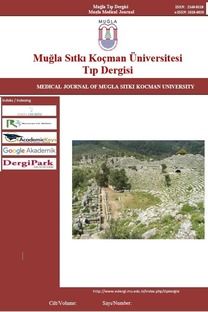İki Farklı Zaman Aralığı ve İki Ayrı Merkezdeki Kolorektal Cerrahide Anastomoz Kaçaklarımızın Literatür Eşliğinde Değerlendirilmesi
Kolorektal Karsinom, Anastomoz Kaçağı, Risk Faktörleri, Cerrahi Morbidite, Mortalite
The Evaluation of Our Anastomosic Leakages Developed on Colorectal Surgery in Two Different Times and in Two Separate Centers Across the Literature
Colorectal Carcinoma, Anastomotic Leak, Risk Factors, Surgical Morbidity, Mortality,
___
- 1. Koperna T, Schulz F. Relaparotomy in peritonitis: Prognosis and treatment of patients with persisting intraabdominal infection. World J Surg. 2000;24:32-7.
- 2. Radenovski D, Georgiev A. Relaparatomy in middle aged and elderly patients with peritonitis following a primary operation for digestive pathology. Khirurgia (Sofiia). 1998;51:29-32.
- 3. Bokey EL, Chapuis P, Fung C, et al. Postoperative morbidity and mortality following resection of the colon and rectum for cancer. Dis Colon Rectum. 1995;38:480-6.
- 4. Soeters PB, de Zoete JPJGM, Dejong CHC, et al. Colorectal surgery and anastomotic leakage. Dig Surg. 2002;19:150-5.
- 5. Audisio RA, Papamichael D. Treatment of colorectal cancer in older patients. Nat Rev Gastroenterol Hepatol. 2012;9:716–25.
- 6. Krarup PM, Jorgensen LN, Andreasen AH, et al, Danish Colorectal Cancer Group. A nationwide study on anastomotic leakage after colonic cancer surgery. Colorectal Dis. 2012;14(10):661-7.
- 7. Hennessey DB, Burke JP, Ni-Dhonochu T, et al. Preoperative hypoalbuminemia is an independent risk factor for the development of surgical site infection following gastrointestinal surgery: a multi-institutional study. Ann Surg. 2010;252:325–9.
- 8. Makela JT, Kiviniemi H, Laitinen S. Risk factors for anastomotic leakage after left-sided colorectal resection with rectal anastomosis. Dis Colon Rectum. 2003;46:653–60.
- 9. Bertelsen CA, Andreasen AH, Jorgensen T, et al. Anastomotic leakage after anterior resection for rectal cancer: risk factors. Colorectal Dis. 2010;12(1):37-43.
- 10. Platell C, Barwood N, Dorfmann G, et al. The incidence of anastomotic leaks in patients undergoing colorectal surgery. Colorectal Dis. 2006;9:71–9.
- 11. Gessler B, Eriksson O, Angenete E. Diagnosis, treatment, and consequences of anastomotic leakage in colorectal surgery. Int J Colorectal Dis. 2017;32:549–56.
- 12. Mc Dermott FD, Heeney A, Kelly ME, et al. Systematic review of preoperative, intraoperative and postoperative risk factors for colorectal anastomotic leaks. Br J Surg. 2015;102(5):462-79.
- 13. Nikolian VC, Kamdar NS, Regenbogen SE, et al. Anastomotic Leak after Colorectal Resection: A Population-Based Study of Risk Factors and Hospital Variation. Surgery. 2017;161(6):1619–27.
- 14. Vasiliu EC, Zarnescu NO, Costea R, et al. Review of Risk Factorsfor Anastomotic Leakage in Colorectal Surgery. Chirurgia (Bucur). 2015;110:319-26.
- 15. Bakker IS, Grossmann I, Henneman D ,et al. Risk factors for anastomotic leak age and leak-related mortality after colonic cancer surgery in a nationwide audit. Br J Surg. 2014;101:424-43.
- 16. Rudinskaite G, Tamelis A, Saladzinskas Z, et al. Risk factors for clinical anastomotic leakage following the resection of sigmoid and rectal cancer. Medicina. 2005;41(9):741-6.
- 17. Golub R, Golub RW, Cantu R, et al. A multivariate analysis of factors cuntributing to leakage of intestinal anastomosis. J Am Coll Surg. 1997;184:364-72.
- 18. Guenaga KF, Matos D, Wille-Jorgensen P. Mechanical bowel preparation for elective colorectal surgery. The Cochrane database of systematic reviews 2011;2011(9): CD001544
- 19. Stumpf M, Klinge U, Wilms A, et al. Changes of the extracellular matrix as a risk factor for anastomotic leakage after large bowel surgery. Surgery. 2005;137:229-4.
- 20. Johansson K, Ahn H, Lindhagen J, et al. Effect of epidural anaesthesia on intestinal blood flow. Br J Surg. 1988;75:73-6.
- 21. Kwon S, Morris A, Billingham R, et al. Routine leak testing in colorectal surgery in the surgical care and outcomes assessment program. Arch Surg. 2012;147:345-51.
- 22. Branagan G, Finnis D, Wessex Colorektal Cancer Audit Working Group. Prognosis after anastomotic leakage in colorectal surgery. Dis Colon Rectum. 2005;48(5):1021-6.
- 23. Fouda E, El Nakeeb A, Magdy A, et al. Early detection of anastomotic leakage after elective low anterior resection. J Gastrointest Surg. 2011;15:137-44.
- 24. Bellows CF, Webber LS, Albo D, et al. Early predictors of anastomotic leaks after colectomy. Tech Coloproctol. 2009;13:41-7.
- 25. Murrell ZA, Stamos MJ. Reoperation for anastomotic failure. Clin Colon Rectal Surg. 2006;19:213-6.
- 26. Walker KG, Bell SW, Rickard MJ, et al. Anastomotic leakage is predictive of diminished survival after potentially curative resection for colorectal cancer. Ann Surg. 2004;240:255-9.
- 27. Petersen S, Freitag M, Hellmich G, et al. Anastomotic leakage: impact on local recurrence and survival in surgery of colorectal cancer. Int J Colorectal Dis. 1998;13:160-3.
- ISSN: 2148-8118
- Yayın Aralığı: Yılda 3 Sayı
- Başlangıç: 2014
- Yayıncı: Muğla Sıtkı Koçman Üniversitesi
Multiple Sklerozda Periferik Sinir Sistemi Tutulumunun Araştırılması
Tuğrul ERGÜN, Çiğdem OBUZ TOPUZ
Yoğun Bakımda Covid-19 Tanılı Gebe Yönetimi: Olgu Sunumu
Tolga KARAÇAY, Canan GÜRSOY, Tümay ÇAKIR, Celal ÖNEL, Bakiye UĞUR
Emrah KILIÇASLAN, Selim SAYIN, Murat YILDIRIM, Tayfun ELİBOL, Hilmi GÖZDEN, Meltem AYLI, Muhammet KAPTAN
Engelli Bakımevlerinde Covid-19 Salgınının Bakım Veren Yükü Üzerine Etkilerinin İncelenmesi
Batuhan AYIK, Hatice KAYA, Didem BEŞİKCİ KELEŞ, Nazife Gamze USTA SAĞLAM
Travma Hastasında Chilaiditi Görünümü
Huriye Gülistan BOZDAĞ BAŞKAYA
Funda DEMİREL, Bahar SARIİBRAHİM ASTEPE
Ciddi Akut Böbrek Hasarı Gelişen Multiple Skleroz Olgusu
Burcu ÇİLEK BALİMRE, Ceren ERDOĞAN EROĞLU, Erkan ŞENGÜL, Zahide YILMAZ GÜNEŞ, Didem YILDIZ TOKSÖZ
Nadir Adnan HACIM, Merve TOKOCİN, Serhat MERİC, Talar VARTANOGLU AKTOKMAKYAN, Soon Sup CHUNG, Yunus AKTİMUR, Haşim Furkan GÜLLÜ, Yuksel ALTINEL
